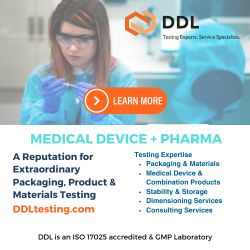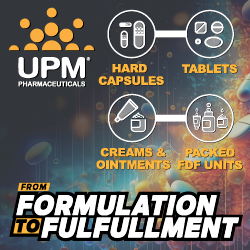Bio Platforms
US FDA Approves Immix Biopharma Rare Pediatric Disease Designation for IMX-110 as a Treatment for Life-Threatening Pediatric Cancer in Children
Immix Biopharma, Inc. recently announced the US FDA has granted Rare Pediatric Disease (RPD) designation for IMX-110 for the treatment of a life-threatening form of…
UAB & Mereo Announce Positive Top-line Results From Phase 1b/2 Trial of Alvelestat in Hospitalized Patients With COVID-19 Respiratory Disease
The University of Alabama at Birmingham (UAB) and Mereo BioPharma Group plc recently announced top-line data from a Phase 1b/2 clinical trial evaluating alvelestat, a…
Cocrystal Pharma’s COVID-19 Oral & Intranasal/Pulmonary Protease Inhibitors Exhibit Powerful In Vitro Potency Against the SARS-CoV-2 Omicron Variant
Cocrystal Pharma, Inc. recently announced in vitro studies demonstrate its oral and intranasal/pulmonary SARS-CoV-2 main protease inhibitors exhibit antiviral potency against the Omicron variant…..
Allarity Therapeutics Submits NDA for Dovitinib for Third-Line Treatment of Renal Cell Carcinoma
Allarity Therapeutics, Inc. recently announced the submission of a new drug application (NDA) with the US FDA seeking marketing approval for dovitinib for the third-line…
Heat Biologics Announces Planned Acquisition of Elusys Therapeutics
Heat Biologics, Inc. recently announced it has executed a definitive merger agreement to acquire Elusys Therapeutics, a commercial-stage biodefense company and the manufacturer of ANTHIM (obiltoxaximab) Injection,….
Hepion Pharmaceuticals Announces FDA Clearance of IND Application for CRV431 in the Treatment of Liver Cancer
Hepion Pharmaceuticals, Inc. recently announced the US FDA has accepted its investigational new drug (IND) application for CRV431, a liver-targeting, novel cyclophilin inhibitor, for the…
Novartis Strengthens Immunotherapy Pipeline With Option, Collaboration & License Agreement With BeiGene
Novartis recently announced the signing of an option, collaboration and license agreement with BeiGene, Ltd. for ociperlimab (BGB-A1217), expanding the company’s research and development activities in immuno-oncology….
Viridian Therapeutics Announces First Subject Dosed in Phase 1/2 Clinical Trial of VRDN-001 for Thyroid Eye Disease (TED)
Viridian Therapeutics, Inc. recently announced the first subject was dosed in a Phase 1/2 proof-of-concept clinical trial for VRDN-001, a monoclonal antibody that blocks the…
Novavax Receives Positive European Medicines Agency Recommendation for Conditional Marketing Authorization of its COVID-19 Vaccine
Novavax, Inc. recently announced the European Medicines Agency (EMA) has recommended granting a conditional marketing authorization for Novavax' COVID-19 vaccine (also known as NVX-CoV2373) to…
Editas Medicine Announces FDA Clearance of IND Application for EDIT-301 for the Treatment of Transfusion-Dependent Beta Thalassemia
Editas Medicine, Inc. recently announced the US FDA has cleared the IND for EDIT-301 for the treatment of transfusion-dependent beta thalassemia (TDT), enabling the company…
Oral Splicing Modifiers That Systemically Lower Huntington Disease Protein Discovered Through PTC Therapeutics' Innovative Splicing Platform
PTC Therapeutics, Inc. recently announced the Nature Communications publication characterizing the novel splicing mechanism induced by compounds identified from the Huntington Disease (HD) program. These…
Poseida Therapeutics Announces FDA Clearance of IND Application for P-MUC1C-ALLO1, a Fully Allogeneic CAR-T Targeting Multiple Solid Tumors
Poseida Therapeutics, Inc. recently announced the US FDA has cleared its Investigational New Drug (IND) application for P-MUC1C-ALLO1, the company’s allogeneic CAR-T product candidate targeting…
Vincerx Pharma Announces First Patient Dosed in Phase 1 Dose-Escalation Study of VIP152 in Relapsed or Refractory Chronic Lymphocytic Leukemia or Richter Syndrome
Vincerx Pharma, Inc. recently announced the first patient has been dosed in the company’s Phase 1 dose-escalation study of VIP152 in relapsed or refractory (R/R)…
Dyadic Announces Research, License & Collaboration Agreement With Janssen for the Manufacture of Therapeutic Protein Candidates Using its C1 Platform
Dyadic International, Inc. recently announced it has entered into a Research, License and Collaboration Agreement with Janssen Biotech, Inc., one of the Janssen Pharmaceutical Companies of Johnson & Johnson…..
Cerevel Therapeutics & Herophilus Announce Collaboration to Evaluate Novel Neuroimmune Modulating Therapeutic Strategies for Schizophrenia
Cerevel Therapeutics and Herophilus recently announced a phased multi-year, joint research collaboration in neuropsychiatry. The collaboration integrates the deep expertise in neuroscience drug discovery at…
Sosei Heptares Enters Antibody Discovery Agreement with Twist Bioscience to Discover & Develop Novel Therapeutic Antibodies Against GPCR Targets
Sosei Group Corporation and Twist Bioscience Corporation recently announced a strategic collaboration to discover therapeutic antibodies against G protein-coupled receptors (GPCR) identified by….
Vaxart to Test Cross-Reactivity of its COVID-19 Oral Tablet Vaccine Against Omicron
Vaxart, Inc. recently announced it plans to test the cross-reactivity of its oral tablet COVID-19 vaccine candidate against the Omicron SARS-CoV-2 variant in two different…
uniQure Announces Clinical Update on First Patients in Phase 1/2 Clinical Trial of AMT-130 Gene Therapy for the Treatment of Huntington’s Disease
uniQure N.V. recently announced initial observations on the first four patients enrolled in the lower-dose cohort of its ongoing Phase 1/2 clinical trial of AMT-130…
Fortress Biotech Announces Initiation of Phase 2 Clinical Trial of Triplex for Adults Co-Infected With HIV & CMV
Fortress Biotech, Inc. and its partner company, Helocyte, Inc., recently announced a Phase 2 double-blind, randomized, placebo-controlled clinical trial has been initiated to evaluate the…
Apellis & Sobi Announce EU Approval of Aspaveli (pegcetacoplan) for Treatment of PNH
Apellis Pharmaceuticals, Inc. and Swedish Orphan Biovitrum AB recently announced the European Commission (EC) has approved Aspaveli (pegcetacoplan), the first and only targeted C3 therapy, for the treatment of….
What are Bio Platforms?
Platforms (or asset-independent technologies to capture all kinds of capabilities that can be leveraged across many different drug candidate assets rather than just discovery tools that the term ‘platform’ immediately brings to mind) are ubiquitous in modern pharma. They are the product of an arms race, to secure access to the best capabilities in key areas.
Platform technologies are considered a valuable tool to improve efficiency and quality in drug product development. The basic idea is that a platform, in combination with a risk-based approach, is the most systematic method to leverage prior knowledge for a given new molecule. Furthermore, such a platform enables a continuous improvement by adding data for every new molecule developed by this approach, increasing the robustness of the platform.
But it has often been said that access to the latest technological platforms to aid efficient drug discovery and development is limited to Big Pharma, which can more easily justify the costs of creating and operating these platforms.
Benefits of Bio Platforms
Platform technologies have the ability to radically improve upon current products and generate completely novel products. In this sense, they open up new arenas for drug discovery and development, potentially increasing the number of therapeutic options for patients. Once a single compound or therapeutic has been generated and demonstrates a clinical benefit in patients, it is more likely this platform technology can successfully be applied to other therapeutic areas, derisking future compounds/products.
Complex drugs by their very nature are challenging and costly to manufacture. This, in turn, translates into higher costs for patients and other payers. In order to provide safe and effective therapies at a reasonable price, it is necessary for the industry to develop manufacturing technologies that reduce costs and provide a consistent product. While the initial investment may be larger, manufacturing costs will be lower over time as the manufacturing process is solidified.
Scale and Investment of Bio Platforms
Despite the initial upfront costs, platform technologies inevitably provide pragmatic solutions to production challenges, while yielding safer and more effective therapeutic products. It has often been said that one of the key features that distinguishes “Big Pharma” from biotech is access to the latest technological platforms to aid efficient drug discovery and development.
These platforms range from vast chemical libraries, ultra-high throughput screening and huge genetic databases in discovery, to predictive toxicology platforms, cutting-edge ‘omics’ and even deep-seated knowledge of particular therapeutic areas in development. All these platforms have two things in common: They can be used on any (or many) development candidate assets, and they cost huge sums to establish in the first place, and in a few cases each time they are used as well. Hence their restriction to the largest pharmaceutical companies (and a few of the so-called “big biotechs” that are, in many ways, indistinguishable from the old-guard pharma).
Only when you have hundreds of active projects can you justify the cost of creating and operating these platforms. Or so the mantra goes. It is access to these platforms that keeps the big companies ahead in the race to discover and develop the best medicines (or at least counterbalance the disadvantages of being large and slow-moving, depending on your point of view). But is that just an assertion? How much evidence is there to support the proposition that the efficiency gains due to these platforms outstrips the cost of creating and maintaining them?
Keeping these technologies “cutting edge” has become so expensive that increasingly we hear pharma companies talking of “pre-competitive” approaches to develop the next generation. A group of companies might develop a platform capability they then share. The principle goal of such initiatives is to access even grander and more expensive tools than individual companies could afford, rather than to dramatically cut costs (although sharing platforms rather than developing the same thing in parallel in each silo should at least keep a lid on rising costs).














